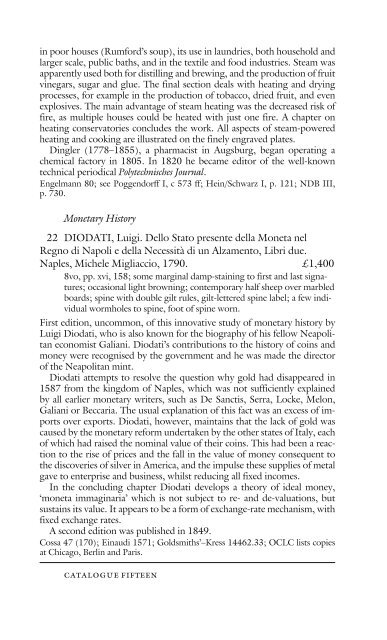Susanne Schulz-Falster Catalogue Fifteen
Susanne Schulz-Falster Catalogue Fifteen
Susanne Schulz-Falster Catalogue Fifteen
You also want an ePaper? Increase the reach of your titles
YUMPU automatically turns print PDFs into web optimized ePapers that Google loves.
in poor houses (Rumford’s soup), its use in laundries, both household and<br />
larger scale, public baths, and in the textile and food industries. Steam was<br />
apparently used both for distilling and brewing, and the production of fruit<br />
vinegars, sugar and glue. The final section deals with heating and drying<br />
processes, for example in the production of tobacco, dried fruit, and even<br />
explosives. The main advantage of steam heating was the decreased risk of<br />
fire, as multiple houses could be heated with just one fire. A chapter on<br />
heating conservatories concludes the work. All aspects of steam-powered<br />
heating and cooking are illustrated on the finely engraved plates.<br />
Dingler (1778–1855), a pharmacist in Augsburg, began operating a<br />
chemical factory in 1805. In 1820 he became editor of the well-known<br />
technical periodical Polytechnisches Journal.<br />
Engelmann 80; see Poggendorff I, c 573 ff; Hein/Schwarz I, p. 121; NDB III,<br />
p. 730.<br />
Monetary History<br />
22 DIODATI, Luigi. Dello Stato presente della Moneta nel<br />
Regno di Napoli e della Necessità di un Alzamento, Libri due.<br />
Naples, Michele Migliaccio, 1790. £1,400<br />
8vo, pp. xvi, 158; some marginal damp-staining to first and last signatures;<br />
occasional light browning; contemporary half sheep over marbled<br />
boards; spine with double gilt rules, gilt-lettered spine label; a few individual<br />
wormholes to spine, foot of spine worn.<br />
First edition, uncommon, of this innovative study of monetary history by<br />
Luigi Diodati, who is also known for the biography of his fellow Neapolitan<br />
economist Galiani. Diodati’s contributions to the history of coins and<br />
money were recognised by the government and he was made the director<br />
of the Neapolitan mint.<br />
Diodati attempts to resolve the question why gold had disappeared in<br />
1587 from the kingdom of Naples, which was not sufficiently explained<br />
by all earlier monetary writers, such as De Sanctis, Serra, Locke, Melon,<br />
Galiani or Beccaria. The usual explanation of this fact was an excess of imports<br />
over exports. Diodati, however, maintains that the lack of gold was<br />
caused by the monetary reform undertaken by the other states of Italy, each<br />
of which had raised the nominal value of their coins. This had been a reaction<br />
to the rise of prices and the fall in the value of money consequent to<br />
the discoveries of silver in America, and the impulse these supplies of metal<br />
gave to enterprise and business, whilst reducing all fixed incomes.<br />
In the concluding chapter Diodati develops a theory of ideal money,<br />
‘moneta immaginaria’ which is not subject to re- and de-valuations, but<br />
sustains its value. It appears to be a form of exchange-rate mechanism, with<br />
fixed exchange rates.<br />
A second edition was published in 1849.<br />
Cossa 47 (170); Einaudi 1571; Goldsmiths’–Kress 14462.33; OCLC lists copies<br />
at Chicago, Berlin and Paris.<br />
catalogue fifteen

















